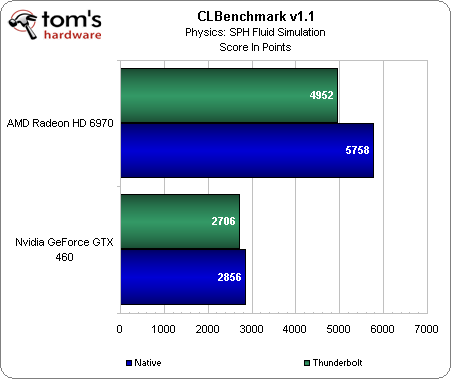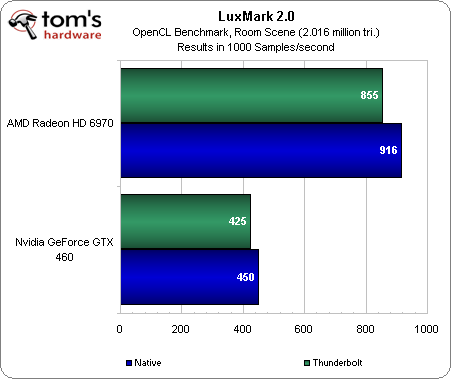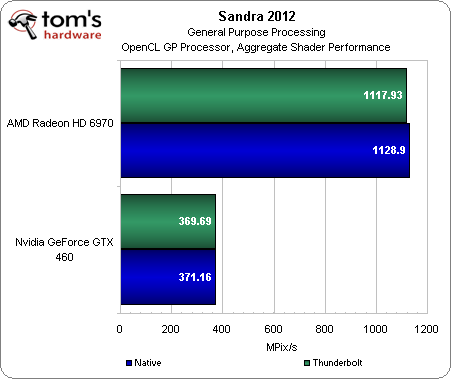Echo Express Pro: Desktop Graphics In A Thunderbolt Chassis
Have the rigors of life on the road forced you to ditch your desktop in favor of a laptop? What if you could add discrete graphics to your Ultrabook? We test the gaming performance of Sonnet's Echo Express Thunderbolt expansion chassis for PCIe cards.
External Graphics Performance: GPU Compute
Sonnet Technologies' chassis wasn't designed for graphics cards. It doesn't expose six- or eight-pin auxiliary power connectors. So, you either need to use entry-level graphics hardware like the Radeon HD 7750, or be willing to run a couple of leads from your PC's power supply. Naturally, that doesn't map over to notebooks, but it still makes for an interesting experiment.
Although we know what the Echo Express Pro was meant to do (enabling performance-oriented expansion for storage, A/V, networking, and so one), dropping a graphics card into the enclosure is way cooler. Most of our excitement stems from the fact that notebook graphics potential is highly dependent on the thermal, mechanical, and electrical constraints of a mobile platform. Taking that outside of the box, so to speak, opens the door to more flexible configurations.
Nowadays gaming isn't the only application for GPUs, though. The breadth of GPU-accelerated software is widening, including compression algorithms, video editing, image editing, and even bitcoin mining. Many of these titles are able to fully utilize a graphics processor's resources, consequently putting more stress on the interconnects linking each subsystem. How big of an impact does externalizing a four-lane PCI Express link have on compute performance?
CLBenchmark is a new tool created by our friends at Kishonti, also known for their GLBenchmark program for iOS and Android. It is similar to LuxMark in that it can test ray tracing and image manipulation; however, we are specifically focusing on its SPH Fluid Simulation benchmark.
As you'd expect, the card plugged straight into a motherboard performs better. But the magnitude of the impact depends on the GPU's performance, it seems. AMD's Radeon HD 6970 runs 14% faster plugged straight in to a 16-lane PCI Express slot, whereas Nvidia's GeForce GTX 460 is only 5% faster. If you're looking to upgrade a notebook with mainstream card without auxiliary power connectors, it's probable that Thunderbolt won't negatively affect its potential much at all.
LuxMark tells us a similar story. The Radeon HD 6970 takes a much larger hit than Nvidia's GeForce GTX 460. The 6970 is not particularly realistic in this application, though, given its power requirements. Boards with more conservative power needs should perform almost as if they were running in a native x16 slot, even if you attach them via Thunderbolt using Sonnet Technologies' chassis.
Diagnostics like SiSoftware's Sandra specialize in isolating specific subsystems. This title's general-purpose processing module effectively factors out interface bandwidth as a variable, putting most of its emphasis on the GPU. As a result, it doesn't really matter if you operate over a native 16-lane link or Thunderbolt's 10 Gb/s channel.
Get Tom's Hardware's best news and in-depth reviews, straight to your inbox.
Current page: External Graphics Performance: GPU Compute
Prev Page Taxing Thunderbolt With PCIe-Based Solid-State Storage Next Page External Graphics Performance: Gaming-
amuffin Well, getting a laptop that supports thunderbolt is already pretty expensive. Then, you have to get one of these which ranges from $400-$800. THEN you have to buy a dedicated card....Reply
It's pretty expensive once you add it all up :/ -
yobobjm I like it, but I see limited use for it, especially for those of us who already have large towers, and don't really want another small tower added on to that. That being said, this would make a pretty awesome home dock for a laptop, and good for those tiny desktops that intel, apple, asrock, zotac and many others make (once all of those get thunderbolt).Reply -
acku Prices will go down. Remember that.Reply
Second, it's about the cost you'd have to pay anyways for a desktop (which you need if you want to game since you can't on a vanilla ultrabook), so its more like an alternative solution for those who want a single system setup.
Cheers,
Andrew Ku
Tom's Hardware -
mayankleoboy1 any controller + the surrounding ecosystem that is this expensive cant survive much. Not being a hater, but being a realist.Reply -
acku You don't know that :). USB 3.0 was expensive when it first came out. Look at things now. Wow things have changed. Prices are substantially lower now.Reply -
Vorador2 Needs to be cheaper. That's my only serious gripe.Reply
And well, for this purpose Thunderbolt still needs to be faster to fully take advantage of the external GPU, best around 16 Gb/s since it's the speed of a 16x PCIE 3.0 slot.
Although you could potentially sidestep this issue if you use two linked thunderbolt interfaces, but then there's the problem of synchronizing data transfers (and finding a laptop with two thunderbolt interfaces...if there's any) -
Menigmand If they can make this much cheaper, I would be very interested. I prefer to game on a laptop so I can easily stow it away when I have guests over and need the dining table. An extra box would be ok, as long as it doesn't need an external display.Reply -
assasin32 Well this makes things more interesting, when the price goes down and becomes resonable within probably the next few years it may give us the ability to buy laptops and attach some reasonble GPU's to them so we can play games on them a lot better.Reply
If this was around 8 years ago I would have been all over it and had it for my laptop since I used to use that for gaming.


